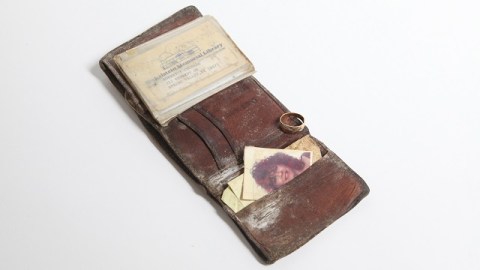How (and Why) to Remember 9/11

This year’s incoming class of college students were born in 1995, making them 6 years old when the United States was attacked on September 11, 2001. In a few years, first-year college students will have little to no memory of the “day when everything changed.” For those of us who witnessed those events as adults, the memories feel as close as yesterday: the confusion of initial news reports, the nationwide scramble for some semblance of safety, the seemingly endless television coverage, all capped off by then-President George W. Bush’s address to the nation that evening. On the 12th anniversary of 9/11, the questions of how to remember and why we remember still hold us. The Stories They Tell: Artifacts From the National September 11 Memorial Museum by Clifford Chanin and Alice M. Greenwald helps us consider possible answers to those lingering questions. As Greenwald writes, “The Memorial Museum is defined by four key commitments: preservation, commemoration, education, and inspiration.” Somewhere within those four “commitments” each of us can find our own form of commitment as to how (and why) to remember 9/11.
When the National September 11 Memorial opened on the 10th anniversary of the attacks, Joe Daniels writes, “the Memorial [became] the physical embodiment of the unity and resolve that defined the days and weeks that followed th[o]se attacks.” But when the 9/11 Memorial Museum opens in spring 2014, it will “provide a permanent record not only of what happened that day but of the events leading up to it, the recovery efforts, and the ongoing and ever-evolving effects of those attacks on our world today.” Whereas the memorial speaks to the heart seeking solace, the museum speaks to the head and heart seeking understanding on an intellectual and emotional level. The museum’s mission sounds as daunting as the initial recovery effort, but the need is just as important (and the drive behind it almost as heroic).
The Stories They Tell offers a sneak peak at what the museum itself will look like and how it differs from nearly every other museum. “While most museums are buildings that house artifacts,” Greenwald writes, “the 9/11 Memorial Museum is literally housed within an artifact.” The museum stands within the very shadow of the downed Twin Towers. Exhibition spaces will exist in the very footprints of the buildings, adding to the powerful presence of the artifacts shown. Surviving elements of the building itself, such as the slurry wall originally designed to keep the Hudson River at bay during the original construction of the towers, merge into the design of the museum. Remnants of the cutoff box columns marking the exterior of the towers can be seen on the ground. As you descend a staircase to the museum’s lower level, you walk beside the Vesey Street staircase used by survivors of the towers to escape that itself somehow survived the collapse. While some might find that parallel descent chilling, Greenwald counters that the stairs “remind us that, in some sense, we are all survivors of 9/11, living now in a world defined by that seminal event.” The physicality of the museum itself, when it opens, might overwhelm visitors at first, but it will be interesting to see how that visceral experience evolves as we learn how to use the museum and its collection to remember.
The Twin Towers defined “big” for New Yorkers. The 9/11 Memorial Museum tries to reproduce much of that epic scale through select artifacts. Two of the steel “tridents” that helped make up the World Trade Center façade will greet visitors entering the museum. More than 80 feet tall and weighing more than 50 tons each, the tridents will stand in for the larger-than-life stature of the buildings that once dominated the skyline. On a slightly smaller, but just as symbolic scale is the “Last Column,” the final column removed by workers after it long, almost stubbornly resisted efforts to remove it. The community of workers who searched through and removed the wreckage at Ground Zero adopted the “Last Column” as a symbol of the resolve and determination of the people who worked for months and years at the site.
In addition to the story of the buildings and the workers, the museum tells the story of the first responders and the sacrifices they made on that day. Badges, boots, and helmets provide almost ghostly reminders of the men and women who they once belonged to. The museum houses an entire fire engine as well—Engine 21, which stood partially under an overpass that protected the still-pristine rear of the engine while the front cab was burned out by the collapsing buildings. It’s a startling sight and a reminder of just how large a role chance played in survival on that day.
But the most powerful artifacts in the collection featured in The Stories They Tell are the smallest, the ones that tell the stories of the individual citizens who died in the attacks: a transcript of Brian Sweeney’s farewell phone call to his wife from Flight 175 before it struck the South Tower; one of the red bandanas that Welles Crowther carried since childhood and used to cover his face as he helped others to safety; the American Airlines flight attendant’s wings carried into battle in Afghanistan in memory of Sara Low, who died serving on Flight 11 that struck the North Tower. I’ll never forget the story behind Robert Gschaar’s recovered property (shown above). Robert’s widow donated to the museum his wallet filled with everyday items (library card, transit pass, a photo of his wife) as well as his wedding ring. She also donated a $2 bill to match the $2 bill found inside the wallet. Robert presented his wife with the bill as a symbol of the second chance their marriage (the second for both of them) gave them and their children. How can anyone look at those items and not think of how many second chances were taken away on that day?
The Stories They Tell: Artifacts From the National September 11 Memorial Museum and the museum itself (when it opens next spring) teach us how and why to remember. Daniels stresses the fact that the “fundamental commitment” of the institution is “ensuring that future generations will know the story not only of 9/11 but also of 9/12—a story affirming that, when circumstances required, the world came together with limitless compassion.” Politicians once condemned “September 10th thinking.” The Stories They Tell celebrates “September 12th thinking” at its best—a generosity of the spirit, a heroism within us all, and a strength to continue moving forward despite the terrible knowledge that the anarchy and insanity that spawned the attacks exists in our world. The Stories They Tell doesn’t ask us to wallow in the sadness of that moment in time, but rather to find inspiration in the stories that rose from the ashes. We remember 9/11 not to commemorate the evil of that day. We remember 9/11 (and remember it better thanks to the September 11 Memorial Museum) to celebrate the good of that day, and every day since.
[Image:Robert Gschaar’s Recovered Property. Collection September 11 Memorial Museum. Photo by Amy Dreher.]
[Many thanks to Rizzoli USA for providing me with the image above and a review copy of The Stories They Tell: Artifacts From the National September 11 Memorial Museum by Clifford Chanin and Alice M. Greenwald.]





